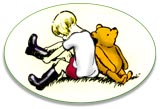 A.A.
Milne always acknowledged that it was his wife,
Daphne, and his young son, Christopher Robin, who
inspired him to write the poems and stories – the
literary journey began in 1924 when the Very Young
Christopher Robin was introduced to an American
black bear at the London Zoological Gardens. A.A.
Milne always acknowledged that it was his wife,
Daphne, and his young son, Christopher Robin, who
inspired him to write the poems and stories – the
literary journey began in 1924 when the Very Young
Christopher Robin was introduced to an American
black bear at the London Zoological Gardens.
My searches for the origins of Pooh have led me
along many paths for 'the truth,' as there are
various versions of Pooh's beginnings. My very dear
friend, the late Sir Basil Bartlett, Bart, formerly
married to Mary Malcolm, the first BBC Television
Announcer, was, among many other things, that rare
breed, a diarist.
His daily journals, recorded over a period of fifty
years are fascinating reading. I have read only
about twenty years' worth, but well recall an entry
dated some time in the nineteen twenties recording a
dinner he had attended at the London home of the
late Laurence Irving, grandson of Henry Irving, the
legendary Victorian actor and the first Knight of
the English theatre.
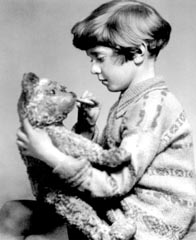 |
|
Christopher
Robin Milne with Pooh,
Cotchford Farm, Sussex, c. 1925
|
During the dinner, Irving
related to his assembled guests the story of how his
neighbour, Alan Milne, had asked him if he would
include his son, Christopher, in their next family
visit to the London Zoo. Irving agreed, as he felt
sure Christopher would enjoy both a day with his
children and what would be the young boy's first
visit to the Zoo. The expotition took place a few
days afterwards. All was fun and excitement for the
children, until their arrival at the polar bears'
'house.' At his first sight of the huge white
'monster,' Christopher burst into tears and insisted
on being taken home.
The party, led by Irving and followed by one
miserable crying child who wanted to leave and two
very unhappy crying children who wanted to remain,
hurriedly left Regent's Park. Some weeks later,
Milne lunching at the Garrick Club with Irving, told
him a story of Christopher's first triumphant visit
to the Zoo, where he had met and fallen in love with
a bear and that this had inspired him to write a
poem or two to celebrate the occasion and perhaps
even eventually a story honouring the visit!
Basil read this extract from his diary to me on the
day Irving had written a letter to the London Times,
containing a brief description of the origins of
Pooh, which totally conflicted with the story Irving
had related to Basil fifty years before.
The following day, I rang Laurence Irving and
reminded him of Basil's written record of the event
all those years before. He insisted that Basil had
romanticised his recollection and he then wrote a
letter to me confirming some of the 'facts' printed
in the Times. Irving's version relates that he took
Christopher on a family outing to the London Zoo
with his daughter, Pamela, and the daughter of their
mutual friend, John Hastings Turner, and that, after
a little trepidation, the young boy decided he liked
the huge and friendly bear.
The writer, Enid Blyton, of The Famous Five fame,
reported that Alan Milne had told her "the bear
hugged Christopher Robin and they had a glorious
time together, rolling about and pulling ears and
all sorts of things." But, I feel it unlikely that a
four-year-old boy could romp about with a
ten-year-old American black bear as Milne described,
but "You never can tell," says Pooh!
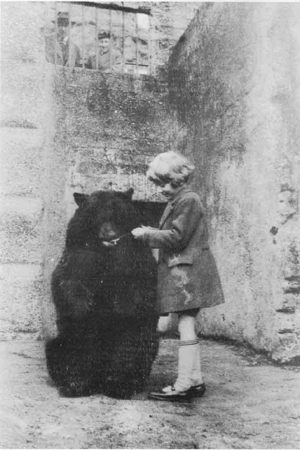 Whatever
the real story is, there is no doubt that the young
Christopher Robin did befriend Winnie at the London
Zoo as is evidenced in the picture of him feeding
the bear with condensed milk on one of his visits.
If you look closely, you will see Alan Milne behind
the bars of the bear's enclosure – was he too
frightened to go in? Whatever
the real story is, there is no doubt that the young
Christopher Robin did befriend Winnie at the London
Zoo as is evidenced in the picture of him feeding
the bear with condensed milk on one of his visits.
If you look closely, you will see Alan Milne behind
the bars of the bear's enclosure – was he too
frightened to go in?
Irving also told me the story of how the determined
Ernest Shepard finally convinced Alan Milne that he
was the best illustrator for his forthcoming book of
verses. Evidently the young artist had gone down to
the Ashdown Forest and made a number of sketches
and, afterwards, without making an appointment,
called on Milne at his home at Cotchford Farm one
Saturday morning with his portfolio of sketches.
Milne, somewhat surprised to see an uninvited guest
at his front door, reluctantly asked him in. Inside
the entrance hall, Shepard opened his portfolio.
Milne was immediately delighted with the drawings
and agreed that Shepard should illustrate the poems.
The young artist left Cotchford Farm clutching his
portfolio a very happy young man. However, two weeks
later, Milne began to regret his 'hasty' decision
and changed his mind. Fortunately, his older and
wiser friends, including F.H. Townsend and E.V.
Lucas reassured him – and history was made.
However, there is little doubt about the origins of
the bear and I am very grateful to Gordon Crossley,
the Regimental Historian of The Fort Garry Horse in
Winnipeg, Canada, who generously gave me the
background history of the original Winnie, the
American black bear cub who was the inspiration for
A. A. Milne's Winnie-the-Pooh, the loveable Bear of
Very Little Brain.
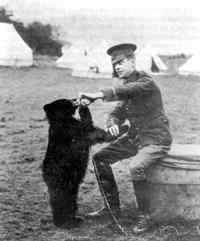 |
Lieutenant
Colebourn with Winnie on Salisbury Plain,
≈December, 1914
© Manitoba Archives, Winnipeg |
In August, 1914, Lieutenant
Harry Colebourn, a Veterinary Officer with the 34th
Fort Garry Horse of Manitoba, was travelling by
train from his home in Winnipeg to enroll in the
Canadian Army Veterinary Corps in Valcartier,
Quebec.
Travelling by Canadian
Pacific Railway, his train made a stop at White
River in Ontario, where he noticed a man further
along the station platform with an American black
bear cub tied to the arm of the bench on which he
was seated.
He struck up a conversation and, learning that the
man was a trapper who had shot and killed the cub's
mother, Colebourn offered him $20 for the young bear
-- the trapper eagerly accepted the offer and the
cub was taken to Quebec, where she became the mascot
of the 2nd Canadian Infantry Brigade, as Harry had
been assigned to the Headquarters of that formation.
One of the units in the 2nd Brigade was the 6th
(Fort Garry) Battalion, which had been formed from
Harry’s old unit, the 34th Fort Garry Horse.
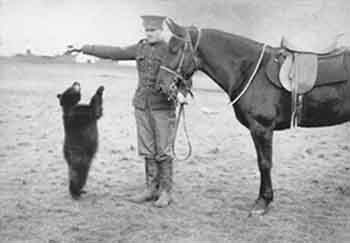 |
Winnie with a
soldier of the Canadian Army Veterinary Corps.
Salisbury plain, 1914
© Archives of Manitoba, Winnipeg |
In December 1914, the 2nd
Brigade was preparing to move to France in great
secrecy. Colebourn decided it was unsafe to take her
into battle; so, while passing through London on the
way to France on December 9th, 1914, he visited
London Zoo and asked them to care for the cub until
his return, which he optimistically anticipated
would be a short time. Of course, 'that war to end
all wars' was not to end so quickly. It was not
until 1918 that Colebourn returned safely to London.
Seeing that the bear, now known affectionately by
her keepers and visitors as Winnie, was happy and
content in her new home, he decided to leave her
there.
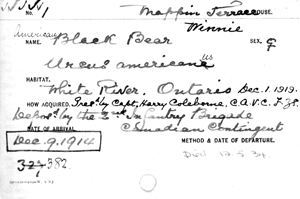 |
Receipt from
London Zoo, recording the arrival there of
Winnie on
December 9th, 1914 and her death on 12th May,
1934 |
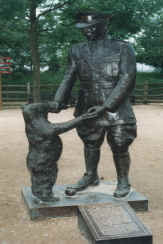 He
visited her a number of times during the following
years to renew his friendship, and the cub grew up
to be a big friendly bear who lived and played
happily among many thousands of friends, both animal
and human, until she died there peacefully on the of
12th May, 1934. In 1921, Harry Colebourn, now a
Major, returned to his old unit, The Fort Garry
Horse, and continued to serve the needs of animals
in the military and as a civilian veterinarian until
his death in 1947. He
visited her a number of times during the following
years to renew his friendship, and the cub grew up
to be a big friendly bear who lived and played
happily among many thousands of friends, both animal
and human, until she died there peacefully on the of
12th May, 1934. In 1921, Harry Colebourn, now a
Major, returned to his old unit, The Fort Garry
Horse, and continued to serve the needs of animals
in the military and as a civilian veterinarian until
his death in 1947.
In 1999 a party of officers
and men from The Fort Garry Horse visited London Zoo
and unveiled a plaque describing the connection
between Harry Colebourn and Winnie. The plaque was
mounted at Mappin Terrace, near the enclosure where
Winnie lived for so many years. The London Zoo also
has a statue of Harry and Winnie, by Manitoba
sculptor Bill Epp. This statue, erected in 1993, is
a copy of the original that stands in the Winnipeg
Zoo
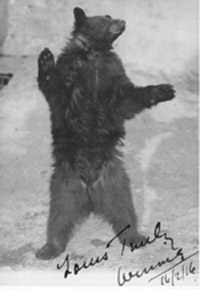 |
Winnie in London
Zoo February 16th, 1916
© Manitoba Archives, Winnipeg |
There's always serendipity
in life – if you allow it – during the late 1950s, I
was employed as Personal Assistant to Harry Arkle,
the European Managing Director of Canadian Pacific
and was offered the job as Personal Assistant to
Neville Crump, the Chairman of the Company in
Montreal – I declined the offer because I was in
love with a girl in London! – If only I'd known
about Winnie-the-Pooh at the time, what other 'bear'
adventures might I have experienced?
Interestingly, Leslie G. Mainland, L.G.M. of "The
Daily Mail" in his book Secrets Of The Zoo published
in 1922, writes of the Zoo's young bear, Winifred.
In Mainland's book, the photograph is captioned
"Winifred being fed by her keeper with a spoonful of
golden syrup."
Milne described
Winnie-the-Pooh's daily 'Little Something' as honey,
a much more 'singy' food! However, the late
Christopher Robin Milne affectionately recalled
that, as a five-year-old boy, he regularly fed
Winnie condensed milk as she disliked honey!
Fortunately for us all, his father immortalized
Pooh's love for honey, rather than condensed milk.
Imagine Pooh singing as he climbed the oak tree:
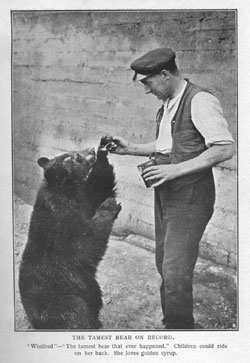
Isn't it funny
How a bear likes condensed milk
Buzz! Buzz! Buzz!
I wonder why he does?
Could a Royal Swan swimming
serenely on the Round Pond in Kensington Gardens
have known it would be called Pooh? "Of course, when
you say goodbye, Pooh is a very good name to take
with you as, probably, the swan wouldn't want it
anymore."
And so, in 1926, with a lifetime of experiences, the
five-year-old Christopher Robin went to live at
Cotchford Farm in Sussex, England, with a friend
named Edward Bear. "Well, when Edward Bear said that
he would like an exciting name all to himself,
Christopher Robin said at once, without stopping to
think, that he was Winnie-the-Pooh. And he was..."
For all time.
Interestingly, Milne wrote the original manuscripts
of the four books by hand with a fountain pen
manufactured by the Swan Pen Company. This may have
prompted his creative mind to invent the story of
the Royal Swan! Milne bequeathed the manuscripts of
Winnie-the-Pooh and The House at Pooh Corner to the
Library of Trinity College, Cambridge, where both he
and his son Christopher had been undergraduates.
Ashdown Forest is much the same today as when Ernest
Shepard first sketched it over seventy years ago.
The Pooh places are now so known and loved that
when, in the late 1970s, it became obvious that
'Poohsticks Bridge' was urgently in need of repair,
the issue was considered of sufficient national
importance to be announced on the BBC 9 o'clock
news.
 |
 |
|
Posingford
Bridge built in 1907 to carry timber from
Posingford to Cotchford Lane on the estate
of Mr. Arthur Clough in Hartfield. The
Estate Manager, John Charles Osman, is
pictured on the left of the photograph with
his thirteen workers.
|
Fully restored,
"Poohsticks Bridge" (as it was renamed) was
reopened by Christopher Robin Milne in 1979.
|
Posingford Bridge, as it was originally called, was
built in 1907 by John Charles Osman and his team of
thirteen workers to carry timber from Posingford to
Cotchford Lane on the estate of Arthur Clough in
Hartfield, West Sussex.
Sufficient funds were raised and the bridge restored
and officially reopened by Christopher Milne in May,
1979. On the day, Christopher was a very unwilling
participant in a game of "Poohsticks" and was
anxious to escape the hordes of press photographers
and journalists. As he walked away from the bridge,
a lady unexpectedly pressed a piece of paper into
his hand, quickly explaining that it was a
photograph of her father, John Charles Osman, the
Estate's Manager, with his workers posing on the
bridge the day they finished building it in 1907.
The only connection to the history of Pooh in
Christopher Milne's house was an enlargement of this
photograph in a wood frame lovingly carved by him
hanging at the top of the stairs of his home in
Devon. After Christopher's death, Lesley Milne
presented the picture to Michael Brown, the Chairman
of the Pooh Properties and it now hangs 'halfway up'
the stairs of his home in Buckinghamshire.
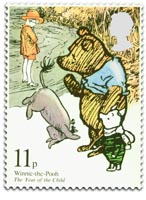 1979
was Ernest Shepard's centenary year and, in July, a
special game of Poohstocks was held on the bridge to
celebrate both the centenary and the issue of a GPO
stamp featuring Winnie-the-Pooh. 1979
was Ernest Shepard's centenary year and, in July, a
special game of Poohstocks was held on the bridge to
celebrate both the centenary and the issue of a GPO
stamp featuring Winnie-the-Pooh.
On Thursday, 20th September,1979, a bronze plaque
was set into a rock in an obscure pathway near the
summit of Gills Lap, the highest point of the
Ashdown Forest in Sussex, commemorating the creation
of Winnie-the-Pooh by A. A. Milne and E. H. Shepard.
There are deliberately no signs to show the way, as
it was felt that the memorial should be informal and
inconspicuous, in keeping with the spirit of the
books. Gills Lap is a point which overlooks all the
Pooh places and is referred to in the final chapter
of The House at Pooh Corner as Galleons Lap.
After an address by Sir Henry Chisholm, then
Chairman of the Pooh Trustees, the plaque was
unveiled by Brigadier L.M. Scott, Chairman of the
Conservators of Ashdown Forest. Christopher Milne
stood alone some distance from the invited guests. I
approached and cheekily introduced myself.
Christopher took my hand and, standing on one leg,
said "Oh, I've heard so much about you." We treasure
a snap Diane took at that very moment, and the
occasion was the beginning of a very close
friendship with Christopher and his family. The
guests then walked back to the village hall for tea,
bread and honey and cakes and I read extracts from
Milne's Pooh books.
A few years ago, Christopher Milne recruited Pooh to
help in the campaign for the survival of Pooh's
Ashdown Forest, then being threatened by the
proposed ravages of a major exploration by British
Petroleum. It was intolerable for Christopher that
such wild, wooded English countryside, once the
hunting ground of Kings, should come under the
threat of so-called 'progress and development.'
Happily, the 100 Aker Wood and Galleons Lap were
saved for posterity. It is rather ironic that Dutton
eventually made an arrangement with British
Petroleum to give away Pooh storybooks as an
inducement to encourage customers to buy their
petrol at gas stations across America. However, the
scheme was not successful and nearly a million
copies of the books lay for some time collecting
dust in the company's warehouse.
Fortunately, Pooh won through. Hearing that the
entire stock was to be shredded and recycled,
Christopher Toyne persuaded K-tel International to
purchase the books from Dutton and have them
packaged with our audio recordings as Read-Alongs
for children. That should please former President
Clinton who, in a Union Address, stressed the
importance of teaching reading to the nation's
children. Pooh may be A Bear of Little Brain, but he
is certainly doing his bit to achieve this aim.
In 1951, at the request of Pooh’s U.S. publishers,
E. P. Dutton & Co. Inc., A. A. Milne agreed that
Pooh and his friends Piglet, Eeyore, Kanga and
Tigger could visit America on temporary loan to help
the publishers sell copies of a new edition of
Milne’s books being issued by Dutton. Roo was unable
to make the journey as he had lost his way many
years before in the woods near Posingford, Sussex.
He had not been seen since! The toys were insured
for $50,000 and Milne exacted a promise from the
publishers that they would not be cleaned and would
be returned to him in England as dirty and
moth-eaten as they were when they left England.
It was anticipated that the animals would tour
America for about three years and then be sent home
to England. For reasons unknown, they have not been
returned to their rightful home. Some years ago,
Gwyneth Dunwoody, the longest serving female Member
of Parliament led a failed attempt to have the
animals returned to England.
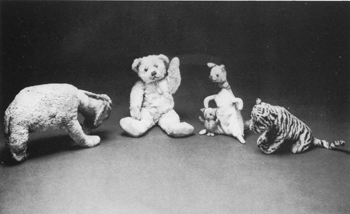 |
|
Eeyore, Pooh,
Piglet, Kanga and Tigger
in the offices of E. P. Dutton & Co. New York,
1987
Photo courtesy of Elliott Graham
|
For over forty
years, the toys were lovingly cared for by Elliott
Graham at Dutton’s New York office. After reading a
newspaper article reporting that the publishers had
taken possession of the 'stuffed animals', Elliott
applied for a job at Dutton. He was quickly
appointed the official guardian to Pooh and his
friends until his retirement as Head of Public
Relations for the company. Pooh and his companions
could not have had a more loving friend. Just before
Christmas in 1987 I had the pleasure of meeting
Elliott and reading Pooh to him and other members of
Dutton's staff.
It was a
privilege to be photographed with Pooh and Elliott,
and these snaps remain cherished memories of our
time together at Dutton. Diane and I had first held
Pooh in 1976, when he traveled by Concorde with
Nancy Winters on a visit to London. Nancy stayed in
her usual elegant suite at the Savoy Hotel in the
Strand, while Pooh was made as comfortable as
possible in the giant steel hotel safe, until he was
released for some exciting expotitions and to be
photographed with us outside the grand entrance of
the Savoy.
The unofficial residence of Christopher Robin's
childhood stuffed animals is now a glass cabinet in
the Donnell Library Center of the New York Public
Library. A party was given there by Dutton on 8th
October, 1996 to celebrate the seventieth
anniversary of the publication of Winnie-the-Pooh in
1926. During our visit to the Donnell in June, 2000,
the cabinet was unlocked for Diane and me to hold
Pooh. He much enjoyed his release from 'captivity'
for a few minutes, taking the opportunity to be
photographed with Jan Lamb, a Library assistant and
to leaf through a few books on the library's
shelves.
In 2002 I innocently permitted the photograph of me
holding Pooh to be published in Brian Sibley’s
wonderful book ‘Three Cheers for Pooh’. My innocent
error was punished with a $700.00 fine imposed by
Anne Hofmann, Chief Librarian of the Donnell Library
Center. In a letter to me dated 23rd October 1995,
Christopher Milne described me as “Pooh’s Ambassador
Extraordinary and no bear has ever had a more
devoted friend” — presumably a view not shared by
Ms. Hofmann. Fear of possible beheading ensured
deletion of the photograph from further editions of
the book and, under threat of legal action, I paid
up!
In my letter to Christopher dated February 26, 1987,
I told him that Dutton had been sold to the New
American Library and then bought by Penguin. Elliott
had told me that the new owners didn’t want the
animals, so Dutton’s previous owner, a 38-year-old
American millionaire financier, John Dyson, took
them to his office on East Fifty First Street in New
York, with the intention of donating them to the New
York Public Library. In his reply to me dated March
3 1987, Christopher wrote “Though I’ve lost touch
with those creatures and don’t specially wish to be
reminded of them, I feel they would be happier in
their native country rather than in the office of an
American millionaire financier.”
Interestingly, Ernest Shepard's beautiful line
drawings of Pooh were not inspired by Christopher
Robin's bear, but by Growler, the much-loved bear
belonging to the artist's son, Graham. Years later,
the tired and worn bear lost a fight with a Scottie
dog in a Montreal garden, where he had gone to live
with Minette, Shepard's granddaughter. A.A. Milne's
own favourite bear was sold to an anonymous buyer at
Bonham's London auction in April, 1995 for £4,600.
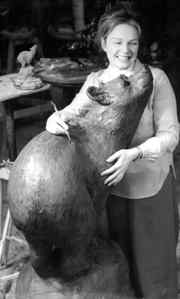 |
|
Lorne McKean in
her studio, Hindhead, Surrey, 1980
|
A lifesize
model of Winnie, immortalized in bronze by the
sculptor Lorne McKean to celebrate both Winnie and
Winnie-the-Pooh, was unveiled by Christopher Milne
at the Mappin Terrace in London Zoo in 1981, when I
was invited to read Milne's In Which Piglet Meets a
Heffalump and the poem At The Zoo to celebrate the
occasion.
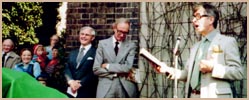 |
|
Michael Brown,
Christopher Milne and Peter Dennis,
London Zoo, September 1981
|
 |
|
Christopher
Milne with bronze statue of Winnie, London
Zoo, September 1981
|
For too long,
Winnie-the-Pooh has been relegated to children's
bookshelves and Disney children's cartoons. But A.
A. Milne didn't write the stories and poems for
children. He intended them for the child within you
– and me – and countless millions of others. Milne
rarely read the stories and poems to his son
Christopher, preferring rather to amuse him with the
works of P.G. Wodehouse. In a letter to me,
Christopher wrote, "My father did not write the
books for children. He didn't write for any specific
market; he knew nothing about marketing. He knew
about me, he knew about himself, he knew about the
Garrick Club – he was ignorant about anything else.
Except, perhaps, about life."
 |
|
Lorne McKean,
Peter Dennis and Christopher Milne with
Winnie, London Zoo, September 1981
|
|